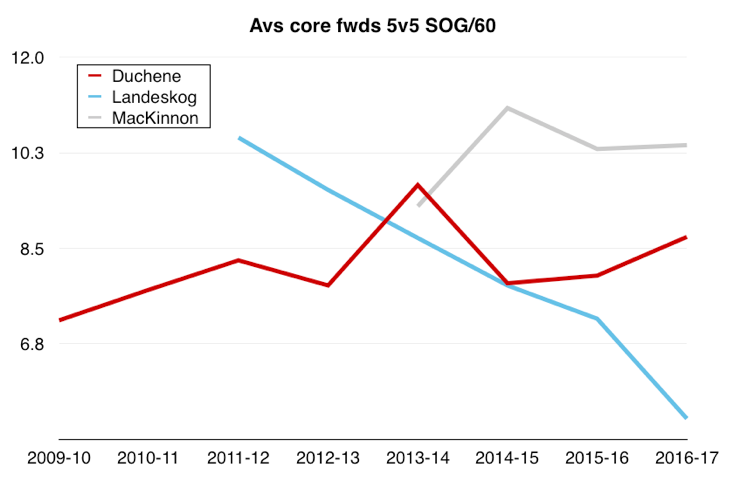Colorado's biggest problem is forward development (Trending Topics)

“What’s the matter with the Avalanche?”
Over the past few years the hockey world has had occasion to ask that question a lot, especially in the wake of that one improbable playoff appearance that of course proved itself unsustainable.
How bad are the Avs today? As Travis Yost pointed out, they’re on pace for one of the worst seasons in recent memory, to the point that they appear to be tanking. Not that anyone would admit whether Colorado was taking a dive for a season or two, but when all outward appearance suggests it, it’s immaterial whether you’re trying. The end result is the same: You can’t score and you can’t win. And this follows seasons in which they finished with 90 and then 82 points, which are unenviable point totals in the first place. Getting worse from there? Not desirable. Unless it is.
But regardless of where they’re at as an organization now, we have to wonder about how they got there. The years of low-grade coaching from Patrick Roy didn’t help. Nor did Roy’s decision to run up the white flag just a few weeks before the season started. Nor did the general lack of defensive depth with which the team entered the season again. Nor did the injuries to the decent defenders it did have. Nor did the creaky veterans. Nor did the general lack of NHL-ready prospects to help keep the team on the upswing.
And to the last point, development — and specifically development of high-end forwards — has been a problem for the Avs for a while now, and no one seems to be talking too loudly about it. They have a Big Three up front of Nathan MacKinnon, Matt Duchene, and Gabriel Landeskog, but none of these players has materially improved their performances in the past few years. In one case, things have actually gotten a lot worse.
Just to start with the real basic-level stuff, MacKinnon hasn’t really matched the output from his age-18 season. He came close last season, but this year he’s dragging once again, and that’s a problem for a guy whose annual performances are supposed to get better until he’s 25 or 26 years old.
Which is, by the way, how old Duchene is now. And yet his performances are just hanging around a level that suggests a very good player, rather than one who’s supposed to be great. That 2013-14 season when he was nearly a point-a-game player offered a tantalizing glimpse, but now he’s settled down over the past three seasons, scoring a respectable but not overwhelming 63 goals over his last 188 games.
Then there’s Landeskog, who kind of always got the poor-man’s-Jonathan-Toews treatment. “He could score more if he wanted to,” and so on. But we don’t really have a lot of evidence this is the case; he’s still good, but he hasn’t really grown as a player — in terms of measurable on-ice performance — in a few years now.

Again, just from a primary points perspective (accounting for goals and primary assists), you can see where MacKinnon really hasn’t done much growing since his rookie year, and where Duchene kind of leveled off since his age-22 season. You can also see where Landeskog has taken a huge step back at a time when his production should be improving.
Obviously looking at just primary point production is a bit reductive, but this tells a story: The Avs rely on these three for their offense, and apart from a few years ago, they really haven’t delivered to an extent you’d like. For context, that midpoint of 1.5 primary points per 60 minutes at 5-on-5 is about where Brendan Gallagher lands this season. And hey, if you have three guys who score like Brandon Gallagher, you’re in pretty good shape, but when they’re supposed to be the three best forwards on your team, that’s a problem. Especially in the case of two No. 1 picks and a No. 2. And especially especially where MacKinnon is concerned because he was supposed to be a franchise-changing talent. Instead he’s Brendan Gallagher? Not ideal.
But again, that’s just in terms of production. Sometimes that can be a little deceiving — though probably not over a period of 200, 400, 500 games — so it’s important to look at the processes that lead to goals in the first place. And in terms of both raw shot attempt totals and actual shots on goal, all three aren’t doing enough to improve their performances to help the team at large.

In terms of attempts, MacKinnon is producing like you would expect a player of his talent to produce, but Duchene hasn’t changed much since he was 19, and here too, Landeskog has cratered. And it’s more of the same when it comes to actually putting their attempts on net:

MacKinnon generally moving in the right direction, albeit incrementally, Duchene plateauing, and Landeskog falling off a cliff.
There are mitigating factors here, to be sure. Playing for a coach whose systems aren’t conducive to generating offense is going to stagnate you. Playing in front of a defense that can’t really get you the puck all that effectively is as well. But still, you’d expect more improvement than “almost none” over stretch of almost three and a half seasons.
This is a team-wide problem. Of course it is when you’re on pace to score only about 170 goals. Duchene leads the team with 12 goals — a decent enough total for 30 games — but MacKinnon has the same number as Rene Bourque, and Landeskog is only one ahead of Blake Comeau.
If, as several have suggested, this offensive futility leads to Joe Sakic sacrificing one of those three forwards to the trade gods for a good young defenseman (and here’s some good news: No one wants to trade for one of those these days!), then the obvious answer is Landeskog. He’s been mediocre and getting worse for some time now, and if he has any value at all left then he must get offloaded at the nearest opportunity before his play further erodes his perceived value.
This goes without mentioning the other young forwards in the Avs’ group, Mikko Rantanen and Mikhail Grigorenko, who have good or even dominant numbers in lower leagues but aren’t any kind of serious difference-makers at the NHL level.
The good news is with the exception of Duchene, who’s mathematically right at the end of the usual uptick in year-over-year production for young players, all these guys probably have room to grow. Landeskog, the team’s captain, is the oldest of the group at 24. And again, if you’re not feeling too good about his prospects for improvement, at least he’s still likely to score 50ish points a year. That’s not nothing.
But this is something the Avs need to look at carefully and soon. Maybe there’s a reason all three of these guys haven’t enjoyed steady improvement in their careers. Maybe it’s the same reason as Landeskog’s apparent decline. And if you can identify that reason, great.
If not, yeah, maybe just blow everything up and see if you can start it all over.
Ryan Lambert is a Puck Daddy columnist. His email is here and his Twitter is here.
All stats via Corsica unless otherwise stated.
MORE FROM YAHOO HOCKEY:

 Yahoo Sports
Yahoo Sports 

